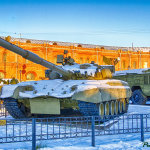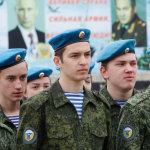The April edition of the Russian Army’s house journal Voennaia mysl’ (‘Military Collection’) included an article entitled ‘Prospects for Improving the Efficiency of Army Defensive Operations’. The article was co-authored by Colonel-General A.V. Romanchuk and Colonel A.V. Shigin. Colonel-General Romanchuk is Rector of the Combined Arms Academy of the Armed Forces of the Russian Federation (VUNTS-SV).1 The Academy is the equivalent of the US Army’s Command and General Staff College at Fort Leavenworth, or the British Army’s Defence Academy in Shrivenham.
The subject of the article was not coincidental. For weeks Russian media has been speculating over a Kyiv spring offensive. The Russian Army has built extensive defensive belts and fortifications across the southern and eastern fronts. This article examines Romanchuk’s ideas for conducting the defensive battle and assesses how realistic they are given the state of the Russian Army after a year of grinding, attrition warfare.
The purpose of defensive operations
Romanchuk opens his argument with a Clausewitz dictum: defence is ‘waiting plus action’. ‘The main goal of defence, he explains, ’is to neutralize the initiative of the advancing enemy, i.e., to bring him to the state of impossibility to continue advancing with deployed forces. Ultimately, this allows you to reduce his activity and seize the initiative by going over to a decisive counter-offensive to defeat the enemy with shock groups.’
This is a rejoinder of Soviet-era orthodoxies and has been the over-arching framework of the annual strategic-operational exercises for decades. Moscow always assumed NATO would attack first. Exercises such as the famous Zapad (‘West’)-1977 represented a NATO surprise attack, including nuclear strike, followed by a massive Soviet and Warsaw Pact counter-offensive which aimed to reach Paris within one month. Zapad-2021 played the same basic scenario but on a greatly reduced scale and without the nuclear aspect. The imaginary attack by ‘West’ was launched against a thinly disguised Belarus, rescued by fraternal Russian forces launching a counter-offensive.
In his article, Romanchuk offers the example of Operation Balaton (the German Operation Spring Awakening) (6-15 March 1945) on the 3rd Ukrainian Front – for obvious reasons – and highlights ‘a bold manoeuver of the reserves…especially artillery, the skilful use of anti-tank reserves, vigilant detachments of obstacles and the arrangement of fire ambushes.’ Balaton/Spring Awakening was the very last German counter-offensive, swiftly followed by the collapse of the Nazi regime. Will this be the fate of the ‘neo-Nazis’ in Kyiv, the article implies.
Be careful, Romanchuk cautions; in the post-war period, positional defences ‘according to the ‘not a step back’ principle’ have become obsolete. Looking for lessons in Balaton/Spring Awakening may mislead. He lists depth strike, UAVs, airmobile operations, remote mining and many other factors as examples of how a modern battlefield has changed. ‘These trends,’ he concludes, ’indicate a significant change in the nature and content of military conflicts compared to the period of the Great Patriotic War, which, in turn, requires the improvement and clarification of many provisions of the theory of military art.’
Romanchuk’s proposed updated defence doctrine
Romanchuk offers a mix of the old and new, as well as the contradictory. His first prescription is that defence must necessarily be based on ‘dispersed’ forces. Likely reflecting the numerical thinness of Russian forces and the sheer length of the front lines in Ukraine (over 800km of active fronts), he argues that holding everywhere ‘cannot be considered rational’. In his words: ‘In our opinion, a dispersed defensive operation should become a logical response to a superior enemy…which is based on the retention of important areas, objects and transport hubs in separate most important directions. Such an operation is characterized by an even distribution of forces and resources in areas, and decentralized use of formations and military units of the armed forces and special forces.’ The schematic below illustrates his concept of ‘dispersed’ defence.

Romanchuk’s ‘dispersed’ defence concept Source: Armeiskii Sbornik April 23 Edition
His answer to the gaps between the dispersed forces is technology. ‘The gaps between important areas and objects can be covered by autonomous stationary or mobile robotic systems (RTC), UAVs, mine-explosive and non-explosive barriers, including those installed remotely. The technical component for organizing dispersed defence is already available.’
The guiding philosophy such a ‘dispersed’ defence is mobility. The Russian Army is already familiar with the idea because ‘manoeuvre defence’ has been the fashionable staple of exercises for a number of years. Dispersed units are not stationary units. Rather, they are ‘decentralised’ and have operational freedom to organize independent counter-attacks and raids, and conduct ‘reconnaissance and strike fire complexes (RUK and ROK).’ He adds, ‘A group of scientists of the VUNTS SV has developed and tested a promising army defensive operation at several command and staff military games for manoeuvre defence.’ It is probable he is referring to Russian war gaming at the highest level of the expected Ukrainian counter-offensive, and how best to counter and defeat.
In the modern ‘transparent’ battlefield, dispersion also offers the advantage of better protection: ‘Under these conditions, special attention, along with the dispersal of troops, should be paid to the preparation of an increased number of hidden and well-protected reserve positions, deployment areas for command posts, ammunition depots, fuel and lubricants and their timely change (up to several times a day), and also the strict observance of camouflage measures, the equipment of many false objects using the latest simulation tools, and the implementation of other effective measures to deceive the enemy.’
His second prescription somewhat contradicts the first. Having rejected ‘positional’ defences, he describes the basic defensive framework as three lines of defence (‘zones of defence responsibility’) with 8-12kms between the lines. The distances correspond with the ranges of medium calibre artillery (Russian guns have not been firing at the often-quoted maximum ranges but rather at more modest ranges). These defence lines he terms, cover, main and reaction (or the reserve). The ‘cover’ identifies the main axes of the enemy advance; the ‘main’ checks the enemy with obstacles and fire strikes; and the reserve mounts the decisive counter attack.
These ideas are not new. Romanchuk is reiterating long-standing Russian defence doctrine, now reflected in the network of defence lines constructed in southern and eastern Ukraine.

The three lines of defence: cover, main and reserve Source: Armeiskii Sbornik April 23 Edition

Russian lines of defence in Zaporizhzhia Oblast Source: Militaryland.net
His third idea is airmobile counter-attack forces: ‘So, the presence of even a small number of subdivisions of the ‘new type’ [re=organised airborne forces] will allow you to combine air and ground operations, quickly create mobile barriers in threatened directions and manoeuver air and ground reserves, for example, to block or encircle settlements captured by the enemy. This also makes it possible to compensate for the lack of forces and means to cover sectors of the front where an enemy breakout is possible.’ The schematic below shows the employment of counter-attacking airmobile reserves.

Airmobile forces used as counter-attacking reserve Source: Armeiskii Sbornik April 23 Edition
Is the proposed defence doctrine realistic in Ukraine?
Romanchuk offers sensible concepts for defence operations. However, it remains questionable whether Russian armed forces in Ukraine could execute the ideas.
First, Russian operations continue to be hobbled by inadequate tactical communications. A remarkable aspect of the war has been an absence of brigade still less divisional operations. After the chaotic charge in the first two weeks of the war and subsequent retreat, even battalion tactical group (BTG)-level operations have been rare. This year, the only example is the fiasco involving 155th Marines in Vuhledar. Instead, the Russian war has degenerated into countless platoon and company level actions – the only level of command confidently controlled with a mix of VHF radios and walkie-talkies. Joint operations – as understood by a Western soldier – are absent.
Second, there is the question of morale. The chmobiks (mobilised soldiers) have only been tested once, during the Kharkiv counter-offensive in September last year. They fled in disorganisation and confusion. Six months later, with no end in sight to their call-up, a willingness to fight remains uncertain. This matters because the chmobiks are filling ranks of depleted regular army units, barely recognisable from original orders of battle. Elite units such as the airborne forces and Spetsnaz have been especially heavily committed and are currently locked in stalemated fronts at Svatove, Kreminna, Bakhmut, and elsewhere. Some reporting suggests these units are also now filled with chmobiks and can no longer be considered elite. Even if the mobilised soldiers enjoyed better morale, do they have the training and skills to execute the type of agile, mobile operations described by Romanchuk?

It all depends on him – will he fight? Source TV Zvezda
Third, what are the Russian armed forces? Today, they are a mix of army units, airborne forces, Spetsnaz and GRU, National Guard, Interior Ministry police, Wagner mercenaries and other PMC groups, BARS reservists, ‘volunteer’ battalions, Chechens, militia battalions, Z-units (Zeks or mobilised convicts in the style of WW2 penal battalions) and naval infantry. Tuvans, Yakuts, Dagestanis, Ossetians, Bashkirs, Tatars, north-west Russians, southern Russians, and other ethnic groups are mixed up. In the communist past, the theory (but not reality) was everybody an equal Soviet citizen. Today, Russian resentment towards the ‘peripherals’ is alive and reciprocated. Tuva is Defence Minister Shoigu’s home territory. The region has been in the news recently because Russian place names are being replaced by Tuvan names, provoking anger in the Russian nationalist community. Wagner’s feud with the Ministry of Defence has turned into a long-running soap opera. The Chechens have withdrawn into their own private world. Discipline is being maintained through beatings and threats. Will this hotchpotch of armed groups hold? Coordinate? Or squabble and disintegrate?
Fourth, Romanchuk advances equipment or tactics that do not exist or are unrealistic. Using heliborne troops as a mobile reserve is not credible. Following the assault on Hostomel Airport on the day of the invasion – an action that cost dearly – there have been no attempts to mount helicopter operations. Russian aviation has lost over 80 aircraft. Many more would be lost if such actions were attempted. The proposal to use technological means to cover gaps does not reflect the reality of Ukraine’s vast spaces and the parlous, worn-down state of the Russian Army’s equipment.
At the time of writing, there is only one certainty: Kyiv will mount a counter-offensive in the near future. Whether Romanchuk’s concepts for ‘improving the efficiency of army defensive operations’ remain neat but unrealisable schematics is an open question.
Sergio Miller
Sergio Miller is a retired British Army Intelligence Corps officer. He was a regular contributor and book reviewer forBritish Army Review. He is the author of a two-part history of the Vietnam War (Osprey/Bloomsbury) and is currently drafting a history of the Russian invasion of Ukraine.





